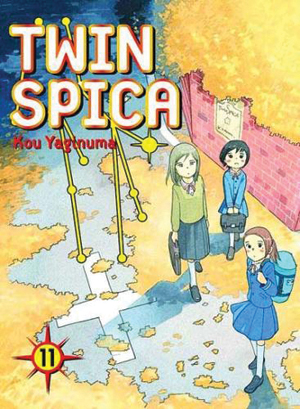
It’s a sign of good storytelling when even the most solemn of reflective moments resonates with the reader in some way, and that’s a skill that mangaka Kou Yaginuma has been honing throughout the run of Twin Spica. If you’ve been following the series up to this point, then you know he dropped a major emotional bomb at the end of the last volume, and so volume 11 is all about picking up the pieces, moving on from tragedy, and trying to find some light in the clearing.
I won’t spoil what happened at the end of volume 10, because it’s fairly substantial and shapes the way the rest of the series plays out. What I will say is that volume 11 spends a great deal of its nearly 400 pages rebuilding and learning from the experience, which ultimately serves as a booster rocket for the dreams of Asumi Kamogawa and her closest friends.
As sad as things may be, it might be just what they needed, because the next stage of astronaut training is some of the most intense they’ve encountered. Their coach takes them to an island for what essentially boils down to a five-day montage, so adjust your manga-reading soundtrack appropriately. As usual, there’s a lot of running and a lot of general endurance. Anyone who falters throughout will be asked to leave, and is essentially done for as far as the program is concerned. Aside from truly putting them through the wringer physically, this leg of training also further tests their resolve to pursue their individual dreams.
Most of all, it tests the ever-mysterious Marika Ukita, about whom we learn a great deal more in this volume. Just as it appears as if we may be barreling toward yet another tragedy involving her and her unique condition, Yaginuma throws a curveball and ends this volume on a surprising note.
As you can see, it’s getting pretty difficult to discuss Twin Spica without spoiling things, so just understand that the series remains a recommended chunk of Vertical Inc.’s library. While I still find Yaginuma’s artwork a bit rough and awkward at times—perspective can get wonky, figures often look crude—but the way he portrays his characters and allows them to grow organically from chapter to chapter is a major selling point. It’s interesting; Twin Spica reads almost like a languid summer vacation, yet it takes the appearance of hanging out with old friends and splatters it all over a relatively high-stakes experience that taxes them to their limits.
Volume 11 packs the Japanese volumes 13 and 14 of Futatsu no Supika together in one hefty package. There’s not much left to go before we finally see how it all ends, and I personally can’t wait until the next set.
Publisher: Vertical Inc.
Story & Art: Kou Yaginuma
© 2012 Kou Yaginuma

